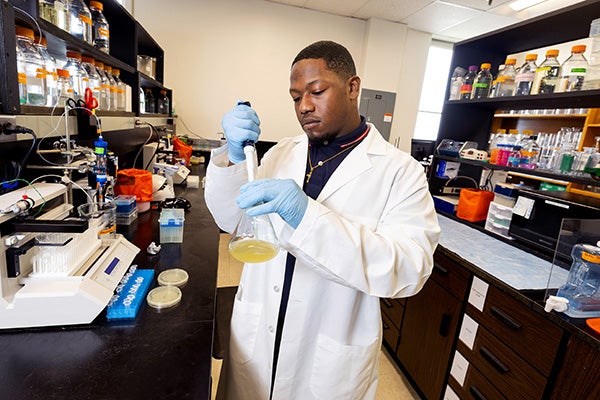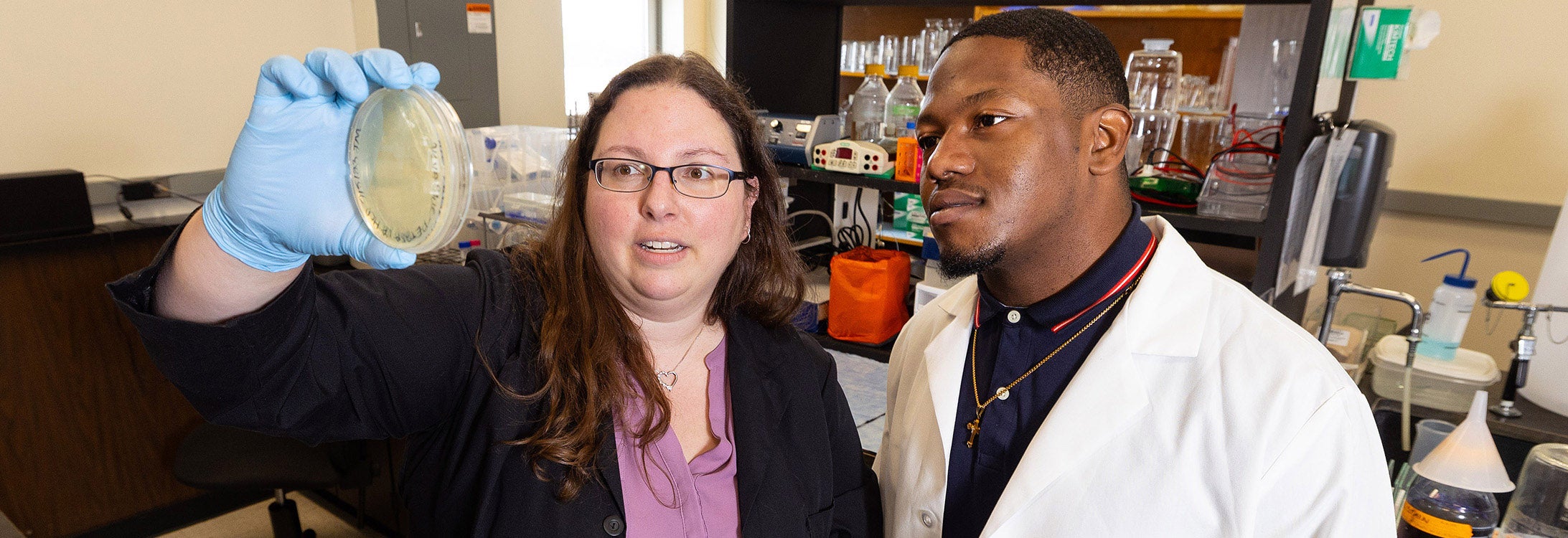BACTERIA RESEARCH
Researchers work to unlock secrets of antibiotic resistance
The word biofilm is fairly intuitive — a coating made by a living thing. It’s not that simple, though. Not by a long shot.
Bacteria make biofilms as a kind of armor, a super sticky matrix that coats a bacterial colony and, when all joined together, the biofilm becomes very difficult to break through. That can make them quite hard to kill, which is necessary to prevent infection and illness from foodborne pathogens.
Morgan Milton, biochemistry researcher at the Brody School of Medicine, and Joshua McLaurin, junior forensic science student from Fayetteville State University, are using the summer to unlock the secrets of bacterial biofilms, defenses that have given rise to antibacterial drug resistant bacterial colonies that impact human health. McLaurin is participating in the STEM Summer Immersion Program funded by the NC GlaxoSmithKline Foundation. The program is designed to build connections between ECU and students from the state’s minority-serving institutions with a goal of establishing pathways to public health graduate education.

McLaurin conducts research in at lab at the Brody School of Medicine.
Milton studies non-cholera strains of the Vibrio family of bacteria. The non-cholera types of Vibrio can still make people very sick, but in different ways: food poisoning and skin infections — have you heard of flesh eating bacteria from contaminated water? The Vibrio that Milton studies cause about 80,000 human illnesses a year that often come from stagnant water that collects after a hurricane or in shellfish due to rising seawater temperatures.
Milton said the cholera strain that has been eradicated from the Unites States gets all the attention in the media, however bacteria like Vibrio she studies are becoming more and more prevalent. And it impacts the economy — raw seafood is less available in the summer because of Vibrio contamination.
Once the bacterial colony hits a population density tipping point, they start to communicate with one another, which signals the cells to create the biofilm. Milton equates it to building a wall around a medieval city to keep out invaders. Learning how and when the bacteria decide to build their biofilm fortress is the goal of her lab’s research.
“There is a whole network of proteins that allow bacteria to say, ‘Hey, there’s enough of me around, enough of us around to start making these biofilms,’ and Josh is going to be working on understanding one of the central proteins within that pathway and we’ve got some really interesting findings,” Milton said.
“If we can figure out long term how these biofilms are being formed, maybe we can stop them before they even start building those walls in the first place,” Milton said. “We are a basic science lab, so we are looking at the nitty-gritty science. We study protein structure function and we’re looking at the atomic structure of proteins, trying to understand how they work on a molecular level.”
Milton and her team of researchers focus on Vibrio fisheri, a species of bacteria that lives in an unbelievable symbiotic relationship with the Hawaiian bobtail squid — the cutest squid you’ll ever see. The squid house the V. fisheri bacteria in a special organ that allows for bioluminescence, which helps with camouflage at night. Science writer Ed Yong has a really good explanatory video of the process that is worth the time to watch, Milton said.
The squids’ bacteria partners are a good research model for Milton and her team because the strain isn’t harmful to humans, or the squid, and replicates the biofilm model of harmful Vibrio, and likely other types of harmful bacteria.
One of the promises of Milton’s research, that McLaurin is now part of, is being able to dissolve the bonds that hold the bacterial biofilm together. The biofilm turns out to be an effective defense for other harmful-to-humans bacteria, which hide in the defenses that Vibrio create.
“What we’re finding in hospitals is that the antibiotic resistant bacteria are very happy to hide in the biofilms of bacteria that aren’t pathogenic,” Milton said. “Once you get rid of that biofilm, antibiotics are effective against the bacteria. Bacteria tend to be 1,000 times more resistant to antibiotics than when they’re alone and free swimming than without the biofilm as a defense.”
This is where McLaurin’s research comes into play. At Fayetteville State, he studies sperm cell proteins to investigate their role in fertilization, which is a world away from bacteria. McLaurin is quick to note that both types of cells are made from proteins, so the move from sperm to bacteria for his summer research assignment in Milton’s lab has been fairly smooth.

McLaurin is getting hands on experience in the lab thanks to a partnership between ECU and Fayetteville State University.
McLaurin hopes to complete his forensic science degree with a minor in chemistry before pursing a doctorate in toxicology with an eye on working in the cosmetics industry.
His prior research is on two proteins called VanU and HCP. Their interaction with each other creates a barb-like structure that the protein uses as an active defense mechanism to fend off harmful microbes. In that sense, McLaurin’s research, at both Fayetteville and ECU, relates to survival strategies for different kinds of cells.
The switch from protein to bacteria research is helping McLaurin to fill his laboratory toolkit. He’s learning a technique called X-ray crystallography, which teases out the atomic structure of proteins by using crystalized protein.
“Looking at the crystal structure of proteins may be another way to help with my research back at Fayetteville State. Dealing with bacteria in general — growing, harvesting, incubating, induction — all are new techniques to me, because those things are more specific with bacteria,” McLaurin said.
McLaurin is enjoying his time thus far at ECU. He came to Greenville with a few fellow Fayetteville students who are also in the FSU~RISE program, which promotes student research and excellence in STEM and biomedical degree paths.
“We don’t work in the same buildings here so I don’t really see them until I go home. But we always talk; I explain my research to them and that helps me understand my research better, which will help me when I have to present at the end of the summer for our symposium,” McLaurin said.
Milton beams when talking about having McLaurin in her lab. Unlike other Brody research labs, the majority of Milton’s research students are undergraduates. McLaurin is part of Milton’s drive to involve undergraduate students in foundational research, and as a bonus, he brings a fresh set of eyes to the lab’s research because he wasn’t a bacteria researcher until landing on ECU’s campus in June.
“Josh has been able to come in and hit the ground running with his own perspectives,” Milton said. “I love seeing the little light bulbs go off. Being able to share those breakthrough moments with students is my absolute favorite.”
Through the summer immersion program, Milton and other participants also are receiving help outside of the laboratory to build the skills necessary to be competitive as graduate students and ultimately in health sciences career fields.
“We have professional development workshops every Friday where we talk about professionalism, wellness and well-being — how to find the right people to be around; to find the right mentors,” McLaurin said.
